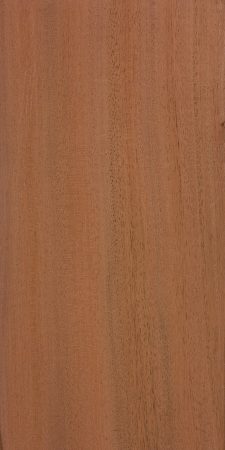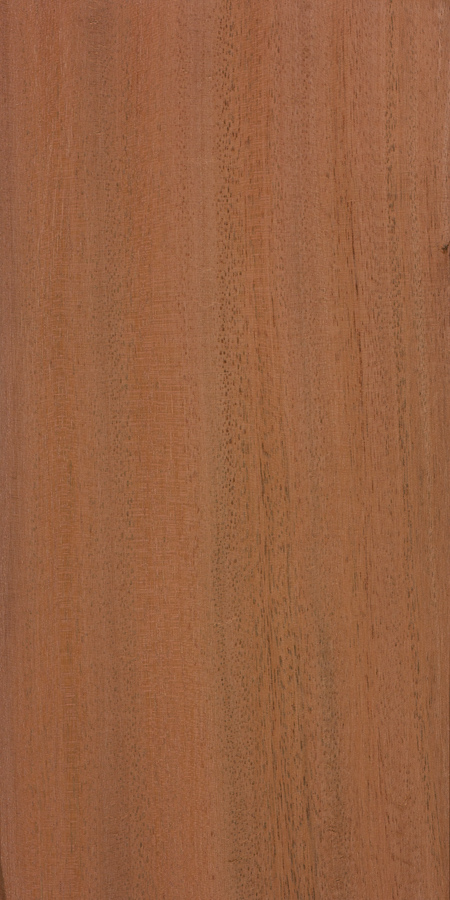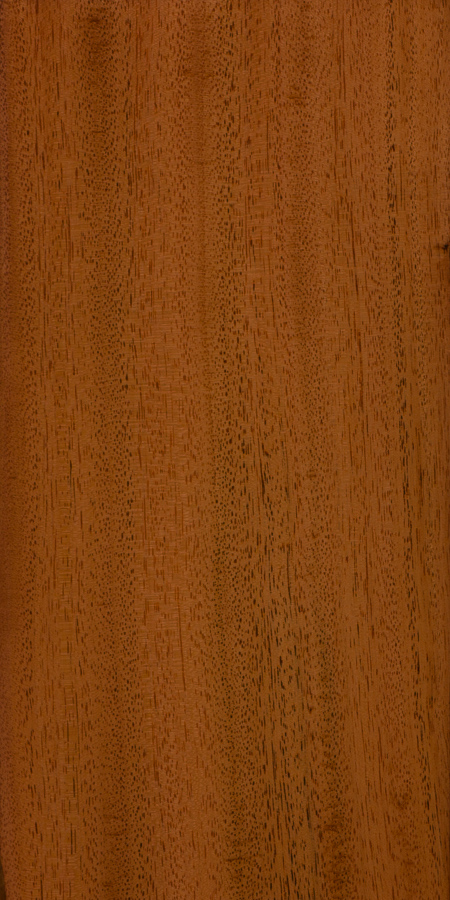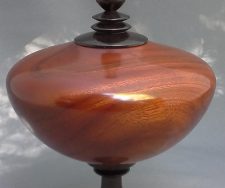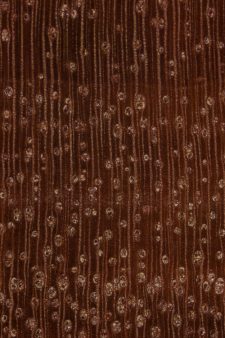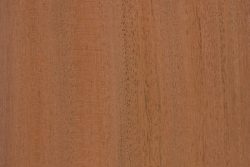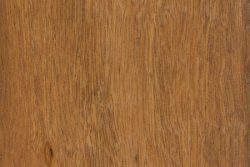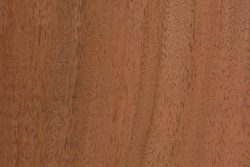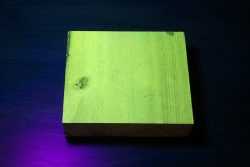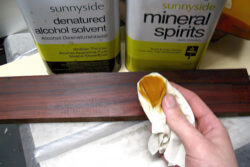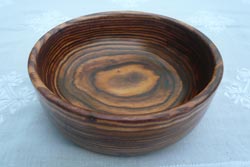DATA SOURCE(S): 8,27,30,36,39,43
Common Name(s): Willow-leaf red quebracho, quebracho colorado chaqueno, red quebracho
Scientific Name: Schinopsis balansae
Distribution: South America (primarily Argentina, Paraguay, and Central-West Brazil)
Tree Size: 40-80 ft (12-24 m) tall,
2-4 ft (.6-1.2 m) trunk diameter
Average Dried Weight: 75.5 lbs/ft3 (1,210 kg/m3)
Specific Gravity (Basic, 12% MC): 1.05, 1.21
Janka Hardness: 3,450 lbf (15,340 N)*
Modulus of Rupture: 18,340 lbf/in2 (126.5 MPa)
Elastic Modulus: 2,192,000 lbf/in2 (15.12 GPa)
Crushing Strength: 12,090 lbf/in2 (83.4 MPa)
Shrinkage: Radial: 4.9%, Tangential: 8.0%,
Volumetric: 12.2%, T/R Ratio: 1.6
Color/Appearance: Heartwood color typically a light to medium reddish brown, sometimes with darker blackish streaks. Color darkens upon prolonged exposure to light. Pale yellow sapwood distinct from heartwood, though transition is gradual. Can have moderate ribbon figure on quartersawn surfaces due to interlocked/roey grain. Overall appearance can resemble genuine mahogany (Swietenia macrophylla).
Grain/Texture: Quebracho has a fine, uniform texture with a high natural luster. Grain tends to be irregular, roey, and interlocked.
Rot Resistance: Quebracho is rated as very durable, and is also resistant to insect attacks. Quebracho also has good weathering characteristics.
Workability: Difficult to work on account of its density and irregular grain. High cutting resistance, as well as pronounced blunting effect on cutters. Dries slowly—and tends to crack, check, and warp while drying. Turns and finishes well, and also able to take on a high natural polish without any finishing agents.
Odor: There is no characteristic odor associated with this wood species, though it is reported to have a bitter taste.
Allergies/Toxicity: Although severe reactions are quite uncommon, quebracho has been reported as a sensitizer. Usually most common reactions include skin and respiratory irritation, as well as nausea. See the articles Wood Allergies and Toxicity and Wood Dust Safety for more information.
Pricing/Availability: Very seldom available in North America, quebracho is much more commonly harvested and processed for its natural tanins, or minimally-processed and used locally in heavy construction. Small log sections, craft blanks, or sawn lumber can sometimes be found on a limited basis. Expect prices to be in the medium to high range for an imported hardwood.
Sustainability: Quebracho is not listed in the CITES Appendices, and the IUCN reports that Schinopsis balansae is a species of least concern. However, this IUCN evaluation dates back to 1998 and is in need of updating.
Common Uses: Due to its difficult workability, quebracho tends to be minimally processed. Local uses include heavy construction timbers, railroad cross-ties, and fence posts. When exported, uses include furniture, carvings, and turned objects.
Comments: The name quebracho is from the Spanish quebrar hacha, which literally means ‘axe breaker.’ Aptly named, wood in the Schinopsis genus is among the heaviest and hardest in the world. The added descriptor colorado, Spanish for ‘red,’ is sometimes added to the name to help distinguish it from an unrelated species, Aspidosperma quebracho-blanco, which goes by the common name quebracho blanco (white quebracho).
Quebracho was heavily exploited in the late 1800s for use in leather tanning. The tanin-rich heartwood (up to 20-30%) is cut into small chips, where the tanins can subsequently be extracted.[1]Record and Hess. Timbers of the New World. p. 48
In addition to Schinopsis balansae (represented on this page), there is another very similar species that is also sold and harvested as red quebracho: S. lorentzii. According to Record and Hess, Schinopsis lorentzii is “more abundant in the drier western plains and is sometimes referred to as the Santiago type (quebracho colorado santiagueno),” while the closely related S. balansae, also harvested and sold as quebracho, “extends into the swampy lands fringing the Parana and Paraguay rivers, is known as the Santa Fe or Chaco type (quebracho colorado chaqueno).”[2]Record and Hess. Timbers of the New World. p. 48
Special comment on quebracho Janka hardness: This wood previously had a very high Janka hardness value listed, formerly 4,570 lbf (20,340 N), and for several years it also topped the list of hardest woods on the Wood Database. However, a recent discovery of an additional source[3]Martinuzzi, F. (2010.) Fichas Técnicas de Maderas. INTI Madera y muebles. has forced me to recalculate this value. By default, I calculate each of the mechanical values as an average value drawing from all credible/original sources. But for this particular data source, I had ignored the reported values for many years because (i) the authors didn’t list the units of measurement used for Janka hardness, (ii) the values cited did not closely match any known units of measurement for Janka hardness, and (iii) the authors did not respond to my email inquiry. The recent breakthrough finally came when I compared the Janka hardness values of other tree species from this source with their known values from other sources. I could then see that the values corresponded perfectly to decanewtons (daN)—this is a very uncommon unit (Newtons (N) or kilonewtons (kN) are much more common), and it’s the only instance I’m aware of where decanewtons have been used for Janka hardness. However, taken as a whole, the actual data from this source tends to be quite reliable, including the Janka hardness of many other species, so I thought it fit to incorporate the Janka hardness values for this source into the average calculation. This had the effect of bringing the average value down significantly—both for Schinopsis balansae and S. lorentzii.
Images: Drag the slider up/down to toggle between raw and finished wood.
A special thanks to John Volcko for providing the turned photo of this wood species.
Identification: See the article on Hardwood Anatomy for definitions of endgrain features.
Porosity: diffuse porous; growth rings generally not visible, though occasionally discernible due to subtle change in color of woof fibers around the annual growth ring boundaries
Arrangement: solitary and radial multiples
Vessels: medium to large, few to moderately numerous; tyloses common
Parenchyma: vasicentric and unilateral
Rays: narrow width, normal spacing; rays generally not visible without magnification
Lookalikes/Substitutes: Superficially, quebracho has an overall appearance that’s similar to various types of mahogany. However, quebracho’s very high density should serve to separate it from nearly all lookalikes.
Notes: Heartwood fluoresces a yellowish green under a blacklight.
Related Content:

